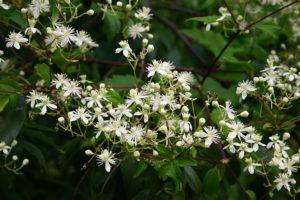Vol. 15 Issue 2, Summer 2010
By Mary Lopresti

Virginia Clematis
Photo by SB Johnny via Wikimedia
With approximately 297 different types of species, it is no wonder that the clematis has so many unique nicknames. A few names of our native Clematis virginiana, which include Virgin’s Bower, Devil’s Darning Needles, Devil’s Hair and Old Man’s Beard, are derived from the appearance of the plants long, feathery seeds and most likely from the plants toxicity.
Early travelers and pioneers of the American Old West used the clematis as a substitute for pepper, since black pepper at the time was so expensive and hard to obtain. Unfortunately, clematis is highly toxic and can cause irritation to the skin and mucous membranes, excess salivation, blistering, inflamed eyes, abdominal cramping, weakness, as well as other unpleasant side effects. Native Americans, however, were able to use very small amounts of clematis as an effective treatment for migraine headaches, nervous disorders, and skin infections. Regardless, it is a good idea to wear gloves when pruning clematis.
Clematis may grow up to 20 feet or higher if it has something nearby that can support its weight, such as a wall or other types of vegetation. The plant can be found growing in thickets and woods and also along roadsides and stream banks. The Virginia Clematis can be found up and down the eastern coast from Canada to Louisiana and as far west as Kansas.
The Virginia Clematis is a trailing perennial vine that has jagged leaves and numerous small, fragrant white flowers. It is easily confused with Sweet Autumn Clematis (Clematis terniflora or Clematis paniculata), an Asian vine that has escaped from gardens. The two vines can be distinguished by their leaves; on the Clematis virginiana, almost all leaves have jagged teeth. Sweet Autumn Clematis has rounded leaves, which are mostly untoothed.
While the Virginia Clematis has numerous small flowers, other species of clematis produce single or double flowers that can range in size from 1 to 10 inches across. They bloom in many beautiful colors from pastels to richly, vibrant burgundy, blue and purple hues, as well. This plant prefers most, rich soils, but will also thrive in dry shade. While the clematis may be a boon to gardeners who wish to attract hummingbirds, butterflies and bees, keep in mind that, if ingested, clematis can be deadly to humans, dogs, cats, birds and other wildlife.
Resources:
http://www.ct-botanical-society.org
http://www.drugs.com/npp/clematis.html
http://www.prairiemoon.com/seeds/trees-shrubs-vines/clematis-virginiana-virgins-bower/
http://www.wildflower.org/plants/result.php?id_plant=CLVI5

